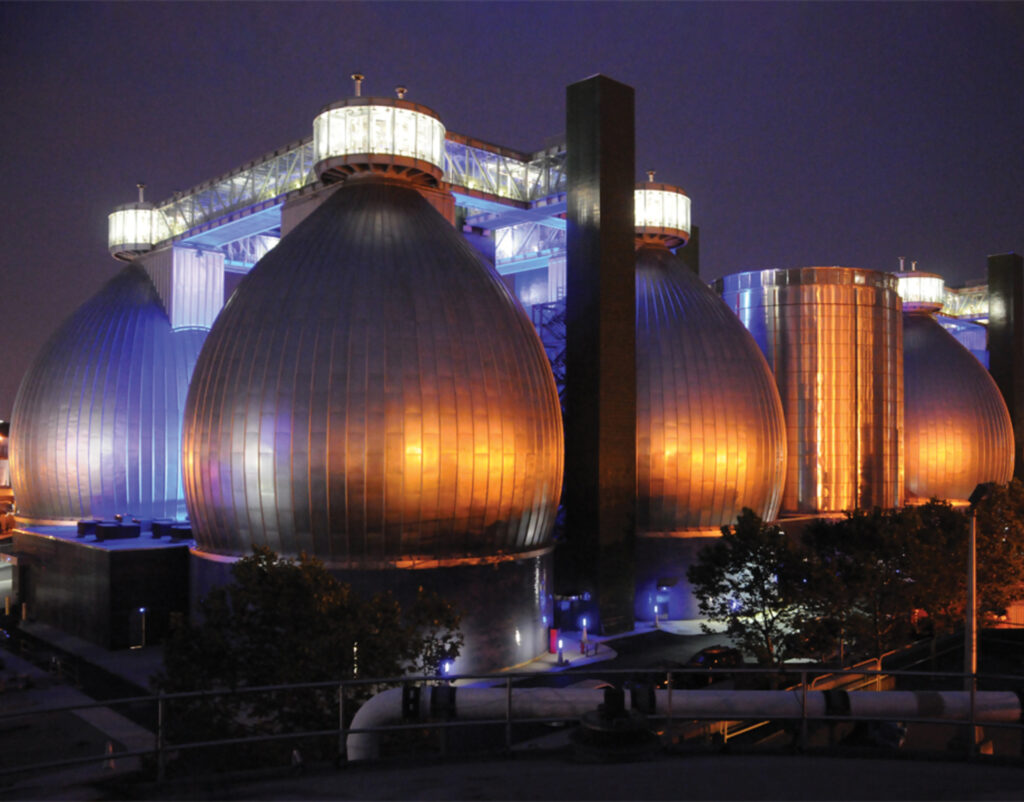A climate activist helps cities turn pizza and vegetable peelings into fuel for municipal buses and trucks.
I arrived early to Joanna Underwood’s charming 1800s brownstone near Union Square in New York City. She was sailing out the front door and said, “Oh my goodness, you’re here already. I was just running to get our bagels at Trader Joe’s. Be right back.”
Bagels fetched, we sat at her kitchen table, the epicenter of her forty years of climate activism, her work well-grounded in research and common-sense pragmatism. Her kitchen walls, covered with photographs of friends, accolades, and family (including her famous musician brother, Ian Underwood of Frank Zappa and The Mothers of Invention) suggested a life well-lived.
“I knew long ago,” she said, leaning over her coffee, “we had to begin leaving fossil fuels underground and find renewable ways of making energy. I asked myself, ‘what can we do now … not way into the future?’”
After her early career writing for Time-Life and later for a company investigating businesses for shareholders, she founded her own environmental nonprofit, Inform, which published more than 100 reports on environmental problems and potential solutions. The organization got its name from Thomas Jefferson: “When the people are well informed, they can be trusted with their own government.”
She moved on in 2007 to create Energy Vision, a nonprofit aimed at ending transportation’s addiction to petroleum-based fuels. From her research, one strategy, little known in the US, attracted her attention: turning organic waste into a renewable natural gas solution.
All the food we throw into landfills, our tossed-away pizzas give off methane…So why not capture it and then use it for better purposes … like powering the city vehicles?
– Joanna Underwood
“Many big cities collect food waste and sewage,” she explained, “and direct it to processing plants where anaerobic digesters capture the methane gas emitted by rotting organics. It’s all right there. All the food we throw into landfills, our tossed-away pizzas give off methane. … So why not capture it and then use it for better purposes … like powering the city vehicles? Too many plants,” she continued, “still flare off their captured methane into the atmosphere, which is very, very bad, so putting it to use is doubly important.” According to Underwood, scientists estimate that methane’s global warming potential is eighty-six times that of carbon dioxide on a twenty-year timeline. She decided to focus her efforts on redirecting that methane toward municipalities with large fleets of trucks and buses that spew gasoline and diesel fumes.
Over the years, Underwood has taken her arguments on the road, attending city councils and meetings with political decision-makers across the country. As a result, dozens of public servants, engineers and scientists, commissioners, and private companies began to share her excitement about methane capture technology and welcomed her as an ally. Municipalities don’t move quickly, but they could see the ultimate cost savings and health benefits embodied in her ideas.
Today, 50,000 buses and trucks in cities including Santa Monica, Los Angeles, New York City, and Sacramento are running on methane gas that, rather than being released into the atmosphere, is instead refined into a clean fuel.

Santa Monica was an early adopter of renewable natural gas. Its Big Blue Bus became one of the country’s first municipal transit agencies to convert its entire fleet, and today, those shiny Big Blue buses transport 44,000 passengers daily across a fifty-eight-square-mile service area. Recently, when I was visiting my brother’s Santa Monica music store, McCabe’s, a handsome Big Blue Bus rambled by. I saluted Joanna.
Today, 50,000 buses and trucks in cities including Santa Monica, Los Angeles, New York City, and Sacramento are running on methane gas that, rather than being released into the atmosphere, is instead refined into a clean fuel.
Joanna’s efforts have also borne fruit in the field of clean alternative fuel production. Brooklyn’s Newtown Creek plant at Greenpoint is New York City’s largest waste treatment plant. In 2014, the superintendent of the plant — with its eight, huge, oval-shaped steel digesters, each containing millions of gallons of black sludge — said he dreamed one day that sludge would be used as a renewable energy source. Last year, with a pipeline infrastructure newly in place, his dream became a reality. In June 2023, Underwood joined the Newtown Creek Project team at the ribbon cutting ceremony. She congratulated the New York City Department of Environmental Protection, the Waste Management program of the state’s Department of Environmental Conservation, and the National Grid for their successful collaboration. Not only were they helping New York City meet its air quality and zero waste goals, but also, she noted, they could become a model for plants across the US. She also mentioned, pointedly: “If only all of New York City’s large waste-processing plants would follow suit, the City’s entire fleet of 6,000 heavy-duty trucks could run on clean fuel and displace twenty-five million gallons of unhealthy diesel fuel.” To that end, Energy Vision is now preparing a guidebook to help other wastewater plants become clean, renewable natural gas fuel producers.

There is always more work to do in New York and around the country. Underwood, is there, indefatigable, on the phone or on the road, advising and cajoling city officials, doing whatever needs doing to tackle climate change. “There is no one solution,” she says, “So I just look for what’s doable.”


